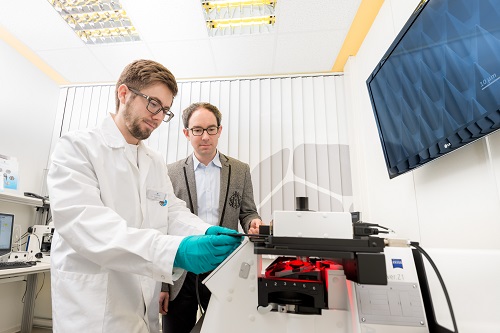Nanoscribe has developed a one-step 3D printing system capable of producing a range of micro-optical components with smoother surfaces, higher shape accuracy and significantly smaller geometrical constraints than those achievable using standard 3D printing technologies.

Nanoscribe's Photonic Professional GT 3D printer can produce a range of micro-optics in a single manufacturing step. (Credit:Nanoscribe)
The new Photonic Professional GT system combines two writing modes in one device: an ultra-precise piezo mode for arbitrary 3D trajectories (FBMS) and the high-speed galvo mode (MBFS) for fastest structuring in a layer-by-layer fashion.
The instrument will allow optical designers to take advantage of the fast and flexible design iterations offered by additive manufacturing, enabling designs to be turned into functional prototypes within a matter of days. An example of this has been carried out by researchers collaborating with Nanoscribe at the University of Stuttgart, who were able to directly print a doublet lens system onto CMOS image sensors, creating a high-performance and compact imaging system. It took the researchers less than a day to implement new designs from the idea to the final part.
The main advantage of additive manufacturing is that it offers greater levels of design freedom and precision compared with traditional manufacturing processes. ‘3D printing… provides the benefit to produce very high quality polymer micro-optics directly,’ said Dr Fabian Niesler, head of applications and processes at Nanoscribe, in a recent article for Electro Optics. ‘With 3D printing, we have almost no restrictions on the shape of optics, because of the way they are produced. You can fabricate micro-optical components that cannot be fabricated with any other method.’ Standard refractive micro-optics, freeform optics, diffractive optical elements and multiplet lens systems can all be printed with the new Nanoscribe system.
Using polymer materials to produce lenses in a single-step 3D printing process will also reduce manufacturing costs dramatically compared to producing glass lenses through multiple processing steps.
According to Niesler, the optics industry is yet to tap into the full potential of 3D printing. ‘I would say that first of all we are only at the beginning,’ he explained. ‘The challenge for people is to completely understand the possibilities that you have with access to a tool such as 3D printing; you have to re-think your design ideas, how you fabricate these ideas.’ In the short term, the materials, in particular the photopolymers, have to improve. ‘Not only do there need to be more materials compatible with 3D printing, but also materials that provide the optical properties necessary for optical applications,’ he continued.
Nanoscribe's Photonic Professional GT system uses a two-photon polymerisation process to achieve feature sizes and line spacings down to 200nm and 500nm respectively.
Hemispherical micro lenses with a shape accuracy better than 1µm, a height of 150µm and a surface roughness better than 10nm Ra have been demonstrated with the system. The company also claim that, by means of a Photonic Professional GT, functional multi-layered diffractive optical elements (DOEs) can be directly patterned onto glass substrates. DOEs can be designed for functionalities that are difficult to achieve using standard refractive optics, such as the generation of almost arbitrary light distributions in the far-field.
Related stories

